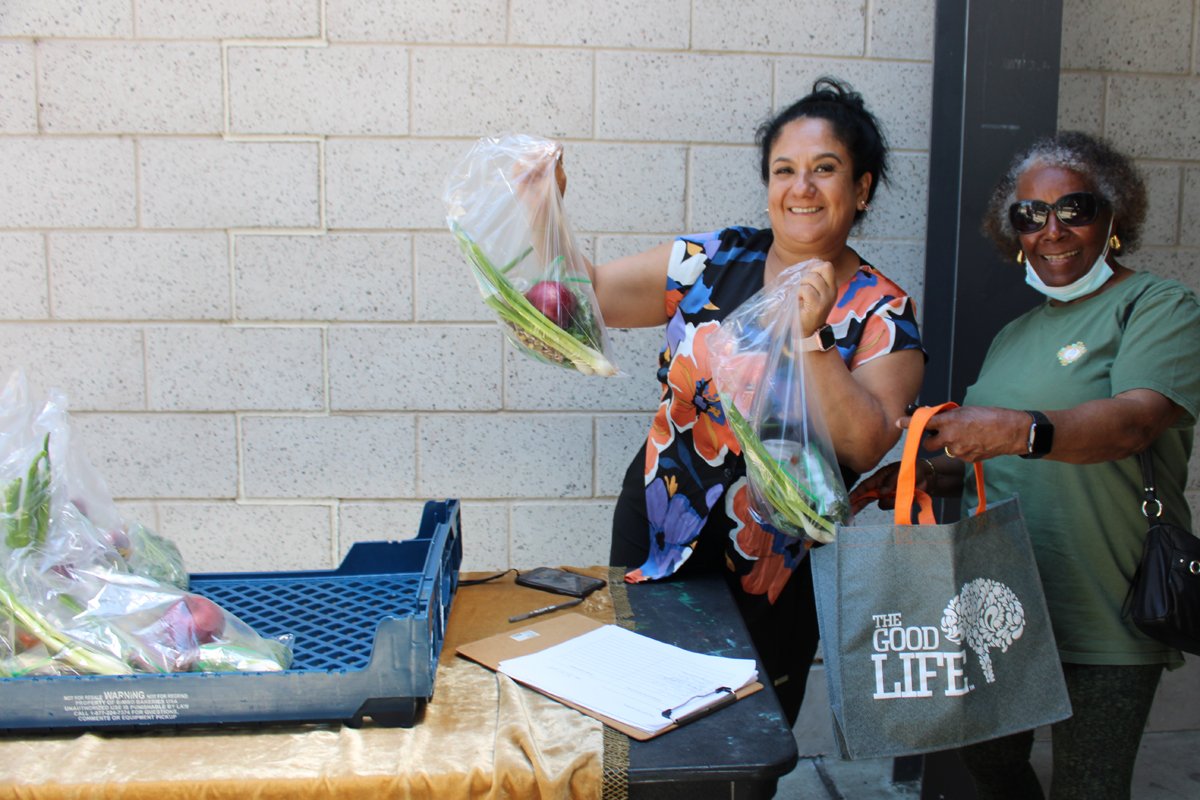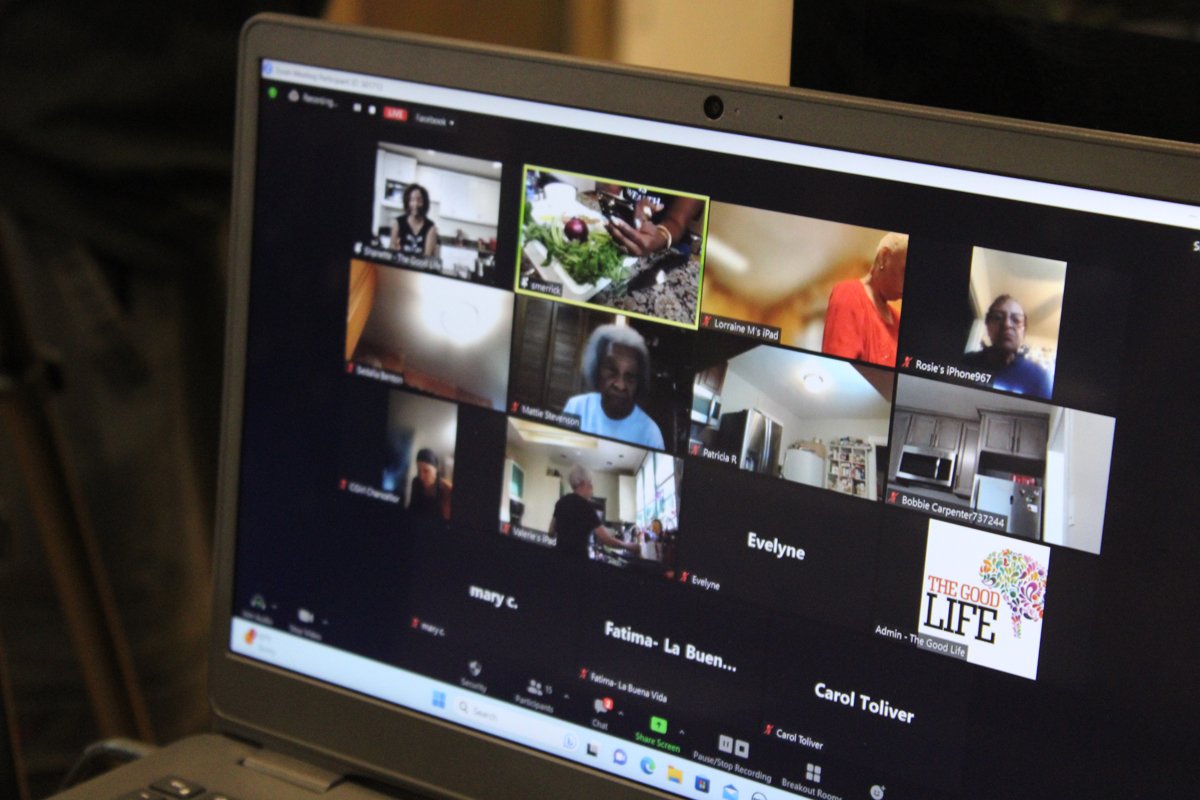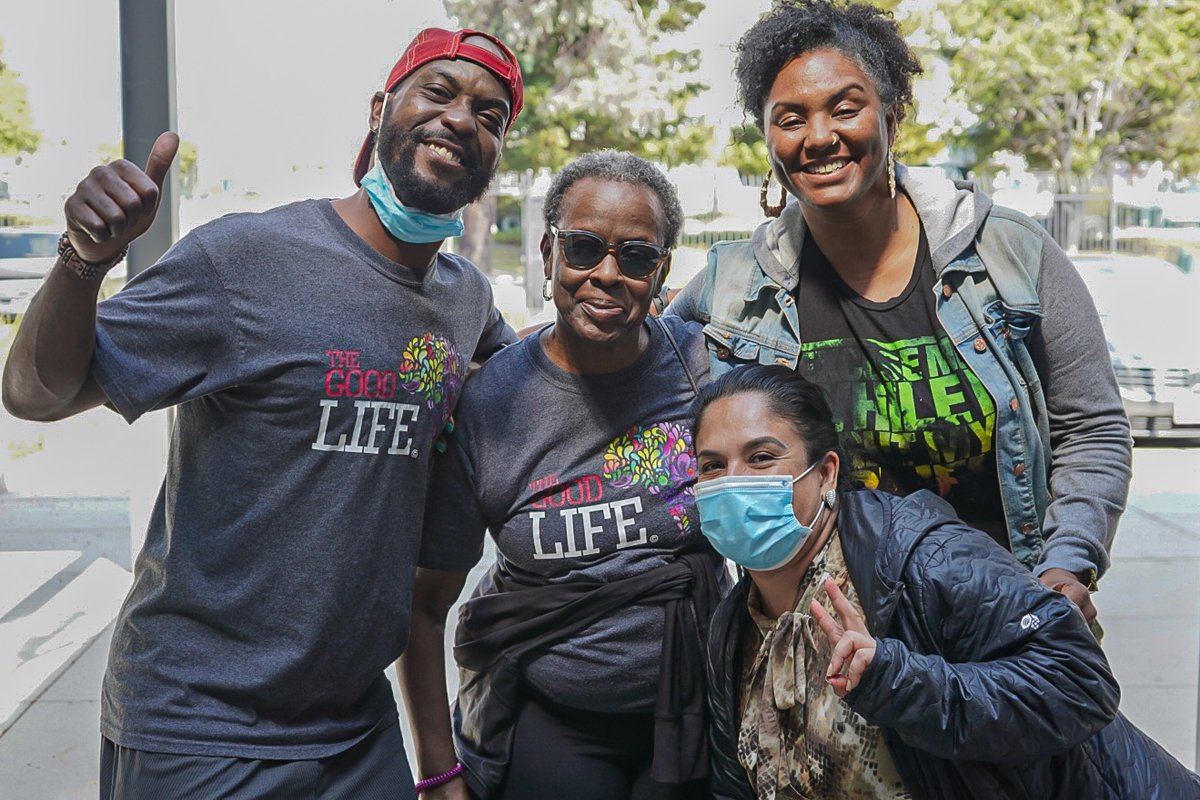New cooking classes for older people of color could delay the onset of diet-related diseases—and provide a host of other benefits, too.

New cooking classes for older people of color could delay the onset of diet-related diseases—and provide a host of other benefits, too.
July 1, 2024

Irma Hernandez and cooking class participant Mary Carriere at the East Oakland Sports Center. (Image courtesy of The Good Life)
Gail Pratt is the oldest of seven sisters and the only one who didn’t learn to cook growing up. When a friend told her about a cooking class at The Good Life, an Oakland, California-based nonprofit offering healthy aging activities for older adults, she decided to enroll. For the past four years, 69-year-old Pratt has logged on most Thursday mornings from her kitchen, joining about 50 other women in her age group from all over the San Francisco Bay Area for an hourlong virtual lesson.
“They teach us how to cook a dish without meat, and I love it,” Pratt, a charismatic New Orleans native, told me on a recent afternoon in Oakland. “I have more energy and I just feel better when I eat better.” Several people in the class, including Pratt, are Black women living with diabetes.
“If you have type 2 diabetes left unchecked, unmanaged, then you are absolutely increasing your risk of developing dementia at later stages of life.”
The Good Life originated in 2020 as a clinical research study on dementia and diabetes prevention led by the U.C. Davis Alzheimer’s Disease Research Center. Some researchers have dubbed dementia “type 3 diabetes” or “diabetes of the brain,” linking blood sugar levels to cognitive decline, though more research is needed to link the conditions.
“If you have type 2 diabetes left unchecked, unmanaged, then you are absolutely increasing your risk of developing dementia at later stages of life,” said Shanette Merrick, U.C. Davis’ clinical research supervisor and The Good Life’s executive director. She and her team recently concluded a study, she said, designed to show that “a healthy lifestyle change would slow down or stop the onset of dementia and diabetes.”

Shanette Merrick’s live cooking class with Mattie Stevenson in attendance, pictured second row from top. (Image courtesy of The Good Life)
Food holds significance at various stages of Alzheimer’s and other dementias—the third leading cause of death for older residents in Alameda County, where The Good Life operates. Early warning signs of Alzheimer’s include forgetting directions to familiar locations like the grocery store and struggling to organize a shopping list. At later stages of the disease, individuals may have difficulty preparing meals and recognizing the food on their plate as edible; some ultimately forget to chew or have difficulty swallowing due to muscle weakness and changes in the brain region responsible for coordination. Cooking and eating nutritious foods, meanwhile, has shown promise in helping individuals maintain and even enhance their cognitive function. Cooking with others may amplify these benefits, by reducing social isolation—a growing problem and one that’s associated with an even greater risk for dementia.
Projects like The Good Life and others around the country are tackling multiple needs. They improve nutrition, social connection, and mental well-being, especially for people living in communities burdened by chronic disinvestment and disease. The Michigan Center for Urban African American Aging Research, for example, is working to feed Black elders while reducing health disparities. With The Good Life, Merrick set out to transform the way Black elders perceive food, hoping to influence dietary changes within entire families. “I see it happening,” she said.
Merrick works closely with David K. Johnson, a clinical psychologist who designed U.C. Davis’ study. He found a civic partner for his research in the city of Oakland. Initially, The Good Life’s cooking and exercise classes were scheduled at the East Oakland Sports Center, which shares a parking lot with a senior center, but pandemic shelter-in-place orders thwarted their plans. Merrick, who lives in East Oakland, proposed online classes to bring people together and address something she was seeing in her community: Black elders grappling with extreme isolation and fear of their vulnerability to the coronavirus. An avid cook and self-identified creative, Merrick offered to teach the cooking class herself. She did not expect classes to last more than a few months, but now, four years later, interest is still growing: Merrick sees 40 to 55 participants weekly, including the core group of around 30 women who’ve been with her since the beginning.
“When they first started the class, I would always add some meat to my dishes, like some shrimp or some chicken,” said Pratt, who is one of those early members. “And now I can do the dishes without the meat, so they’re really helpful as far as teaching us how to cook healthy meatless meals.” (Studies have shown that a vegan or high-vegetable diet may reduce risk of dementia.)
Merrick chooses seasonal recipes from cookbooks and websites to spotlight foods that promote optimal brain functioning and overall health. In recent months, the class has prepared a “Moroccan Style” bowl featuring chickpeas, couscous and roasted root vegetables; “Peanut Chili Noodles”; and various leafy green salads with fresh herbs and homemade dressings. While Merrick prepares a dish on camera, her production manager and fellow cooking instructor Nya Siwatu (also her daughter) explains each ingredient’s beneficial properties. When they finish cooking, the group stays online, eating together and sharing unique twists anyone might have added to the recipe.
“They’re learning how to really look at their plates and say, ‘That heals my pancreas, this is good for my heart, this is good for my skin—everything on this plate is healing my body,’” Merrick said. “That’s super powerful.”
Regular class participants say they’ve changed how they shop, stock their pantries and season their food. They also report having lower A1Cs, the most commonly used measurement for tracking blood sugar levels. Pratt credits The Good Life with decreasing her blood pressure and blood sugar—and as partial inspiration for renting a community garden plot with another participant, Brenda Harrel, 72, a mother and active gardener. The rising costs of food and the short shelf life of fresh produce also contributed to their decision.
“All of the herbs that we use when we’re cooking, we’ll go to the store and buy it, and when we get ready to use it again, it’s no good,” Harrel said.
Harrel and Pratt wanted the option to pick truly fresh produce from their garden for their weekly class. So far, they’ve planted basil, cilantro, parsley, hot peppers, onions, butter lettuce, collard greens, strawberries, cherry tomatoes, and bell peppers.
Not all elders can access a community garden plot or have the energy to tend one. For many, simply getting to a grocery store with a variety of nutritious, affordable foods can be a challenge. California is home to the largest population of adults over 65 in the United States, but many who live on low incomes can’t meet their basic needs, increasing their risk of chronic illness and disease. The U.C. Davis Alzheimer’s Research Center received a $5 million grant from the state to ask, “What are the ways that we cannot only get older adults to exercise and diet, but what are the important differences in the way that Black Americans adopt healthy lifestyles and white Americans adopt healthy lifestyles?” Johnson explained. “Sometimes I call that the study of haves and have-nots.”
“I want to remain mobile. So what do you do? You eat right and you exercise.”
According to the Alzheimer’s Association, older Black Americans are twice as likely as older non-Hispanic white Americans to have Alzheimer’s or other dementias. Latinx Americans are about 1.5 times as likely. And women make up almost two-thirds of Americans living with the disease. Researchers at Columbia University’s Irving Medical Center have attributed the racial disparities to social and environmental factors, including chronic exposure to racism and unequal access to healthy food options. East Oakland is a prime example: Driving with Merrick from the East Oakland Sports Center to the a supermarket for a few red onions was a 2-mile one-way journey, which would have taken 45 minutes on foot or roughly 30 minutes by public transit, each way.
In addition to online classes, The Good Life provides free food, through pickups at the Sports Center to ensure participants get the ingredients they need for the recipes. Merrick says the number of food pickups has nearly doubled since the program started. The day before class, she and her team, including Spanish-language instructor Irma Hernandez, meet at the Sports Center to bag and package the week’s ingredients, usually sourced from a legendary local supermarket, the Berkeley Bowl. An hour later, women start trickling into the Sports Center lobby with reusable shopping bags and backpacks to pick up their ingredients, along with additional food—milk, eggs, vegetables, crackers, chips, and more—donated by the Alameda County Food Bank. During pickup hours, the lobby transforms from an echoey transactional space into a social scene. Many women linger to chat with each other and the staff, filling the air with warmth and laughter. They share cooking stories and catch up on each other’s lives.
Patricia Richard, an active 77-year-old who many credit with telling them about The Good Life, said she visits her neighborhood farmers’ market weekly, but still goes to the Sports Center for specific food items. “I want to remain mobile,” she said. “So what do you do? You eat right and you exercise.” A Good Life participant since it launched, Richard transitioned to a vegan diet a year and a half ago after learning she had partial artery blockage. “I decided that rather than taking drugs, I’ll just go with the diet.”

Patricia Richard (center) with fitness supervisor and trainer Michael Tatmon, Jr. (left), Shanette Merrick (top right), and Irma Hernandez (bottom right). (Image courtesy of The Good Life)
Despite the prevalence of dementia in the Black community, this group is underrepresented in research studies on preventing and treating the condition (though there are signs of improvement). Richard wanted to help researchers collect information “about Black people, about the discrepancies, and why we have so much dementia,” she said, so she joined U.C. Davis’ Alzheimer’s Disease Cohort, an ongoing study for which she undergoes a “grueling” 2.5-hour annual examination involving memory tests, blood work, and an MRI scan. Her involvement will continue for the rest of her life.
In the program’s first two years, Merrick personally delivered ingredients to Mattie Stevenson, an Oakland resident since the 1950s and the eldest participant in her class. When she spoke with me last year, Stevenson told me the cooking class had helped her manage diabetes and a heart condition by teaching her new ways to cook foods she loved and ones she had avoided, like cauliflower. Learning about new utensils provided a surprising benefit. “I just love the potato peeler,” she said. “It’s brought a joy to my life.”
“Loneliness is the most significant mental health issue facing older adults, no matter race, creed, or color—doesn’t matter. People want to be together.”
As this story was being reported, Stevenson passed away, at the age of 95. Merrick said she had come to think of Stevenson as family. On delivery days, the two would often sit on the porch and talk. That Stevenson’s son asked Merrick to speak at his mother’s funeral reflects the bond the two women formed in a relatively short time. “[Her passing] was devastating,” said Merrick. “It’s the hardest thing I’ve had to deal with since I’ve been doing this.” Not long before her death, The Good Life posted a promotional video on YouTube capturing Stevenson for a few moments at the center of the screen, a video that now also honors her memory.
For Johnson, the U.C. Davis psychologist, the power of social interaction and support is a critical facet of The Good Life. “Loneliness is the most significant mental health issue facing older adults, no matter race, creed, or color—doesn’t matter,” he said. “People want to be together.” He plans to publish a paper on his findings in the coming months; for now, he says the combination of maintaining a healthy, whole-foods diet and having a vibrant social life is our most effective defense against cognitive decline and dementia. As for the question he set out to answer about lifestyle differences: “Not all the data is analyzed,” he explained in an email, “but I can say with great certainty that Black Americans feel most at home and therefore most likely to adopt healthy lifestyles when other Black Americans from similar communities (what we call cultural congruence) lead the classes and comport themselves as unapologetically African American.”
The Good Life anticipates serving roughly 1,200 people across all its classes this summer, with around 700 of them participating in La Buena Vida, the Spanish-language version of the organization that launched last year. In Hernandez’s cooking class, participants often prepare vegetarian versions of “traditional Mexican food,” like chiles en nogada and cactus salad, she said. Recently, her class was broadcast to Oakland’s San Antonio Senior Center, tripling the number of participants—and offering a glimpse into the future.
To expand its reach, The Good Life has started building studios in Oakland, with the goal of broadcasting programming to senior centers throughout California. Hernandez says that older adults, including herself, have struggled to engage online because they “didn’t grow up with the technology, don’t have a computer, or internet at home.” Senior centers often have all the tech on-site—and a captive audience. Ten centers have already agreed to partner; they hope to solidify 40 more partners by the end of the year.
Meanwhile, Merrick is focused on scaling to serve people of all ages and facilitate healing across generations within family lines.
“Our kitchens should be our pharmacies; our kitchens should be our spaces of healing,” she said. “We don’t pass down the diabetes gene; we pass down recipes and eating habits.”

October 9, 2024
In this week’s Field Report, MAHA lands on Capitol Hill, climate-friendly farm funding, and more.
October 2, 2024

October 2, 2024

October 1, 2024

September 30, 2024

September 25, 2024

September 25, 2024

Like the story?
Join the conversation.